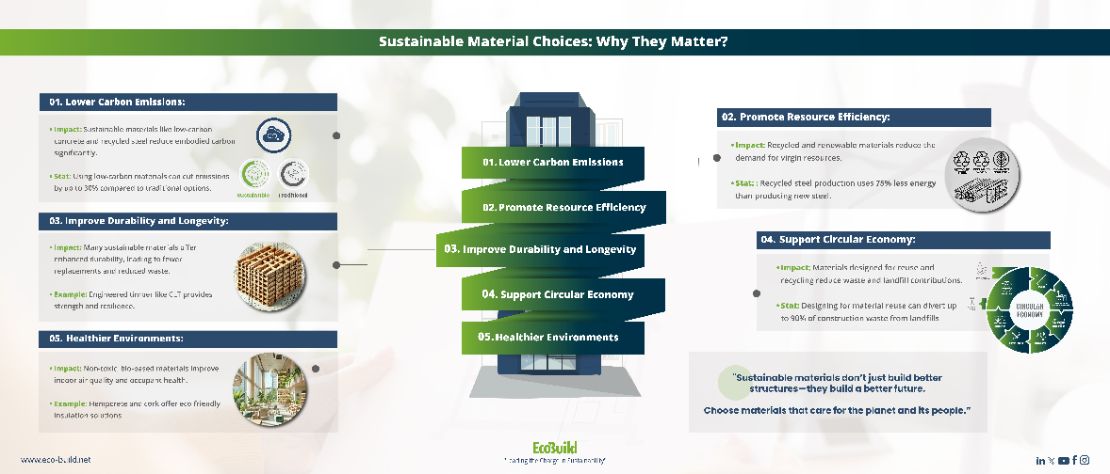
Insight Mar 15, 2025
Innovative Materials for Sustainable Construction
Introduction: Redefining Construction with Sustainable Materials
As the construction industry faces increasing pressure to reduce carbon emissions, innovative materials are leading the charge in creating a more sustainable future. From recycled aggregates to bio-based alternatives, these materials not only lower embodied carbon but also promote resilience, efficiency, and environmental stewardship.
At ECOBUILD, we prioritize sustainable material choices in all our projects to help clients achieve their Net Zero goals. In this blog, we’ll explore cutting-edge materials transforming the construction landscape and how they’re making a difference.
WHY SUSTAINABLE MATERIALS MATTER?
- Embodied Carbon Impact: Traditional materials like concrete and steel contribute significantly to a building’s lifecycle emissions.
- Resource Efficiency: Using recycled or renewable materials reduces the demand for virgin resources.
- Resilience: Many sustainable materials offer enhanced durability, reducing maintenance and replacement costs.
INNOVATIVE MATERIALS TRANSFORMING THE INDUSTRY
1. Low-Carbon Concrete
- What it is: Concrete made with reduced clinker content or alternative binders like fly ash, slag, or recycled aggregates.
- Impact: Produces up to 40% fewer emissions than traditional concrete.
- ECOBUILD Insight: We’ve used low-carbon concrete in multiple projects, significantly reducing embodied carbon without compromising performance.
2. Cross-Laminated Timber (CLT)
- What it is: Engineered wood made from layers of timber bonded together.
- Impact: Acts as a carbon sink, storing CO₂ during its lifecycle.
- ECOBUILD Insight: CLT is an ideal alternative for structural elements in mid-rise buildings, offering both strength and sustainability.
3. Recycled Steel
- What it is: Steel produced from scrap material using energy-efficient methods.
- Impact: Reduces embodied carbon by 25-30% compared to virgin steel.
- ECOBUILD Insight: Using recycled steel supports Circular Economy principles and lowers the environmental footprint of projects.
4. Bio-Based Insulation
- What it is: Insulation made from renewable sources like hemp, sheep’s wool, or cork.
- Impact: Provides effective thermal performance with minimal environmental impact.
- ECOBUILD Insight: Bio-based insulation enhances energy efficiency while contributing to healthier indoor air quality.

5. Mycelium-Based Composites
- What it is: A lightweight, biodegradable material grown from fungal spores.
- Impact: Offers eco-friendly alternatives for insulation and non-structural applications.
- ECOBUILD Insight: Although emerging, mycelium shows promise for reducing construction waste and embodied carbon.
6. Recycled Plastics
- What it is: Construction materials made from post-consumer plastic waste, used in everything from flooring to structural components.
- Impact: Diverts plastic waste from landfills and reduces resource extraction.
- ECOBUILD Insight: Recycled plastics are particularly effective in non-structural applications like wall panels and paving blocks.
CHALLENGES AND OPPORTUNITIES
While innovative materials hold immense potential, barriers like cost, availability, and market acceptance remain. At ECOBUILD, we address these challenges by:
- Conducting Materials Lifecycle Assessments to identify the best options for each project.
- Partnering with suppliers committed to sustainability.
- Educating clients on the long-term benefits of sustainable materials.
CASE STUDY: MATERIALS IN ACTION
In one of our recent projects, ECOBUILD incorporated:
- Low-carbon concrete for the foundation, reducing embodied carbon by 35%.
- Recycled steel in structural elements, saving approximately 20 tons of CO₂ emissions.
- Bio-based insulation for energy-efficient thermal performance.
Conclusion: Building a Sustainable Future
The shift to innovative materials is more than a trend—it’s a necessity for addressing climate change and creating resilient, sustainable buildings. By embracing cutting-edge solutions, the construction industry can significantly reduce its environmental impact while enhancing performance and efficiency.
At ECOBUILD, we’re proud to lead this transformation.
💡 Ready to integrate sustainable materials into your next project? Contact ECOBUILD today to explore how we can help.
